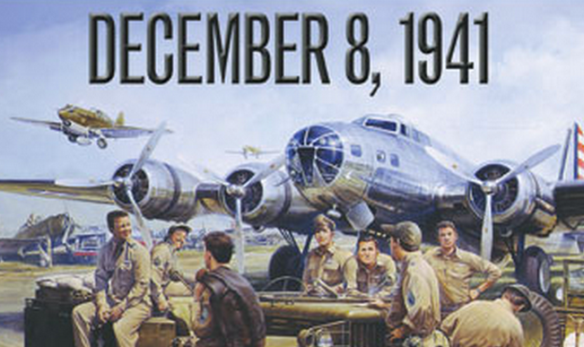Hi Mitch,
Well, I’m not sure my opinion would be short! A good portion of my book, Fortnight of Infamy, delves into exactly this topic. Chapters 2 (“Gateway to China”) and 4 (“A Matter of Hours”) look at issues related to the “strategic bomber deterrent” build-up in the Philippines and the very poor and inadequate basing and support decisions that were made. Chapter 6 (“Disaster on Luzon”) recounts the tactical events of December 8, 1941, on which date both MacArthur and Brereton definitely made significant, still not completely explained, errors in judgment. Brereton’s “top secret” February 1942 report on the subject to Arnold, co-authored by Col. Francis Brady, continues to go missing from the archive files, contents unknown to those still breathing. Chapter 12 (“To Fight Another Day”) provides an extensive analysis of why both the Philippines and Malaya fell so rapidly – more quickly than even the Japanese expected. Naturally, in recognition of your assistance, I’ll be sending you a copy once it is in production.
If one buys Brereton’s own premise – that the Far East Air Force was set up to fail – then a substantial portion of “blame” can fall on the doorstep of Generals Arnold and Marshall, and even President Roosevelt himself. The laundry list of others influencing those decision makers in this regard is long and filled with famous individuals. MacArthur was only swayed toward support by his last-minute orders from the War Department and his faith in Col. Hal “Fighter” George (of whom I’m a big fan). I should point out that Bill Bartsch (Doomed at the Start and December 8, 1941) and I have discussed the topic and remain in disagreement regarding Hal George’s role in this. I’m actually working on another book, tentatively titled Aim Your Arrows toward the Sun: Franklin Roosevelt’s Secret Plans to Bomb Japan. This work will extensively explore the intrigue behind the fateful decision to place bombers in the Philippines in the first place, a decision to which Brereton has been documented as strongly opposing. Fortnight of Infamy only uncovers the tip of that iceberg.
In my opinion, both sides of the debate below have strong merit. Now, I’m not trying to dodge the bullet…
As I point out in my book, although Brereton was on Billy Mitchell’s staff in WWI, he was not considered a traditional “combat commander”. He was a highly talented organizer and manager, and, from the documents I’ve read, certainly no fool. On the other hand, he did not have the masterful public relations skill that MacArthur charismatically and brilliantly employed throughout his career. Interestingly, Brereton was well-liked and respected by the half-dozen or so people that I’ve met who personally knew the man — something I’m afraid I can’t say about the few folks I talked with who actually met MacArthur. I’m actually, personally, pretty neutral regarding MacArthur. I believe he was not a very good tactical commander, but do agree that his virtues outweighed his vices, especially in the larger picture of things. MacArthur was familiar with Brereton’s skills and embraced him enthusiastically until post-war discussions became heated. In addition to Arnold, Ike also seemed to hold him in high regard. (Ike was himself hardly well-qualified for the job originally placed on his shoulders by Marshall.) As for the opinion of Brereton’s peers, one must recall that Brereton was an Annapolis graduate in an arena dominated by Westpointers. Thus, Brereton’s previous Navy affiliation represented a bit of a stigma for many, however petty that may seem.
A couple of my more specific opinions:
- Far too much is made of the decision not to send all the B-17s to Del Monte. As far as I can tell, no one seriously suggested that all 34 operable Fortresses should go to Del Monte, at least not for any extended period of time. After all, had they gone, there would be no planes available for reconnaissance in the Luzon Strait or near Formosa.
- Major Orrin Grover, 24th Pursuit Group CO at Clark Field, deserves much of the blame for messing up the fighter coverage for his own airfield and the B-17s on December 8. In addition to fumbling the dispatch of three fighter squadrons, he may not have properly informed the 19th Bomb Group of the situation, though Lt. Col. Eubank could have taken better precautions for his B-17s on his own initiative. I should point out that history has not heavily challenged Grover’s role until recently, in part because Grover was the individual who wrote the history (ex post facto) of the units involved! Unquestionably, he had motive not to make himself look bad.
- There was no militarily valid excuse for MacArthur’s failure to meet with Brereton in the early morning of December 8. The best use of the Fortresses would have been the planned counter-strike at Takao. A recently promoted Brigadier Sutherland probably deserves some blame in this regard for maintaining an “iron door” between Brereton and MacArthur.
- MacArthur made significant errors in his sudden transition to the execution of War Plan Orange. His lack of preparation for that scenario, in which he was involved for many years before his recall to duty, is astounding – his greatest shortcoming in the war. On the other hand, it really would not have made much difference in the ultimate outcome. Most knowledgeable commanders considered the WPO scenarios a virtual pipe dream by the mid-1930s.
- The Tuguegarao and Baguio raids gave the Japanese the perfect, completely unintentional, decoy. If those raids had not occurred when they did, the fighter dispositions would have been better set to give the IJNAF a hearty reception. In addition, they were the primary reason that the B-17s were scrambled earlier in the morning of December 8, which set the timing for a lunchtime return to Clark. This represented an extraordinary stroke of good luck for Japan!
